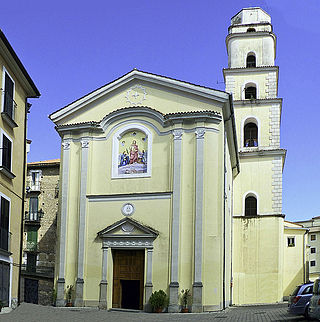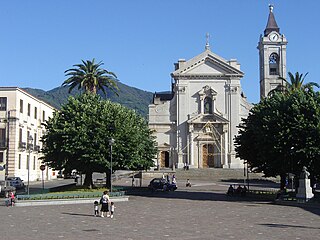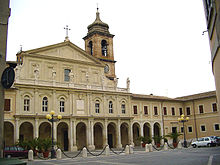History
Terni is the ancient Interamna Nahars of the Umbrians, and the cathedral, and other churches, are built on the sites of pagan temples. After the Lombard invasion, Terni belonged to the Duchy of Spoleto, and with the latter, came into the Pontifical States. It was at Terni that Pope Zacharias entered into the agreement with King Luitprand for the restitution of the cities of Bieda, Orte, Bomarzo, and Amelia to the Duchy of Rome. [3]
It is believed that the gospel was preached at Terni by Peregrinus, about the middle of the second century. Saint Valentinus has a basilica outside the city. There were other martyrs from this city, among them saints Proculus, Ephebus, Apollonius, and the holy virgin Agape.
In the time of Totila, the Bishop of Terni, Proculus of Terni, was killed at Bologna, and Domnina of Terni and ten nuns, her companions, were put to death at Terni itself. After the eighth century Terni was without a bishop until 1217, in which year the diocese was re-established.
Among its bishops were:
Among its saints:

The Archdiocese of Udine is a Latin Church ecclesiastical territory or archdiocese of the Catholic Church in Italy. The see was established in 1752 when the Patriarchal see of Aquileia was divided. From 1818 to 1846 it was a suffragan diocese of the Patriarch of Venice.

The Italian Catholic diocese of Monopoli, in the province of Bari, existed from the eleventh century to 1986. In that year it was united into the diocese of Conversano-Monopoli.

The Diocese of Vallo della Lucania is a Latin Church diocese of the Catholic Church in Campania, has existed under this name since 1945. It is a suffragan of the Archdiocese of Salerno-Campagna-Acerno.

The Diocese of Oppido Mamertina-Palmi is a Latin diocese of the Catholic Church in southern Italy, existing under that name since 1979. Historically it was the Diocese of Oppido Marmertina (Oppidensis). It is a suffragan see of the Archdiocese of Reggio Calabria.

The Diocese of Nocera Umbra was a Catholic diocese in Umbria, Italy.

The Roman Catholic Diocese of Narni, lat. Dioecesis Narniensis, in central Italy, was suppressed in 1907, becoming part of the Diocese of Terni.

The Diocese of Livorno is a Latin diocese of the Catholic Church in Tuscany. It was created in 1806. It is a suffragan of the Archdiocese of Pisa. The current bishop is Simone Giusti.
The Italian Catholic diocese of Bertinoro existed from 1360 to 1986. In that year it was merged with the diocese of Forlì to create the diocese of Forlì-Bertinoro.

The Diocese of Alife-Caiazzo is a Latin diocese of the Catholic Church in Campania, southern Italy, created in 1986. In that year the historic Diocese of Alife was united with the Diocese of Caiazzo. The diocese is a suffragan of the Archdiocese of Naples.

The Diocese of Melfi-Rapolla-Venosa is a Latin diocese of the Catholic Church in Basilicata, southern Italy. In 1986 the historic Diocese of Melfi-Rapolla was united with the Diocese of Venosa. The diocese is a suffragan of the Archdiocese of Potenza-Muro Lucano-Marsico Nuovo. The Abbey of the Santissima Trinità at Venosa comes under the Diocese.
The Italian Catholic Diocese of Amelia, existed from the fifth century until 1983. In that year it was united into the new diocese of Terni, Narni, e Amelia. It was a suffragan of the archdiocese of Spoleto.
The former Italian Catholic Diocese of Città della Pieve, in Umbria, existed until 1986. In that year it was united into the Archdiocese of Perugia-Città della Pieve.
The former Italian Catholic diocese of Alatri existed until 1986, when it was united into the diocese of Anagni-Alatri. Comprising historically seven towns close to Rome, it was under the immediate jurisdiction of the Holy See.
The Italian Catholic diocese of Bitonto, in Apulia, had a short independent existence from 1982 to 1986. In the latter year it was united into the Archdiocese of Bari, forming the Archdiocese of Bari-Bitonto. Before 1982, it had existed since the 9th century until being united into the diocese of Ruvo e Bitonto in 1818.
The Roman Catholic Diocese of Capri was a Roman Catholic diocese located in the city of Capri on the island of Capri, in the Tyrrhenian Sea off the Sorrentine Peninsula, on the south side of the Gulf of Naples in the Campania region of Italy. On 27 June 1818, it was suppressed to the Archdiocese of Sorrento.
The Diocese of Umbriatico was a Roman Catholic diocese located in the town of Umbriatico in the province of Crotone in southern Italian region of Calabria. In 1818, it was suppressed with the bull De utiliori of Pope Pius VII, and incorporated in the diocese of Cariati.

The Diocese of Pienza was a Roman Catholic diocese located in the town of Pienza in the province of Siena, in the Val d'Orcia in Tuscany between the towns of Montepulciano and Montalcino. Until 1462, the town was known as Corsignano. It took the name Pienza from its most famous native son, Pope Pius II, who elevated the town to the status of a city (civitas), and established the new diocese. The diocese existed as an independent entity from 1462 to 1772, directly subject to the Holy See (Papacy).
The Diocese of Caorle was a Roman Catholic ecclesiastical territory in the coastal town of Caorle in the province of Venice, Veneto.
Francesco Maria Scelloni, O.F.M. was a Roman Catholic prelate who served as Bishop of Viterbo e Tuscania (1472–1491) and twice as Bishop of Terni.
Tommaso Vincenzi was a Roman Catholic prelate who served as Bishop of Pesaro (1475–1478) and Bishop of Terni (1472–1475).
This page is based on this
Wikipedia article Text is available under the
CC BY-SA 4.0 license; additional terms may apply.
Images, videos and audio are available under their respective licenses.












